Debt Capacity Made Easy with our Latest Transfer Pricing Solution

Introducing the Debt Capacity module: a powerful new addition to Zanders’ Transfer Pricing Suite, enabling fast, accurate, and scalable debt capacity testing for multinational entities.
In the ongoing efforts to enhance tax transparency for multinational corporations, tax authorities have progressively increased scrutiny on intercompany financial transactions. While the interest rates on intra-group loans have long been a focus of regulatory attention, recent administrative guidelines have shifted the spotlight toward the level of indebtedness of borrowers. For instance, the German Federal Ministry of Finance recently issued new guidelines mandating a debt capacity test for intercompany financial transactions1.
Although many multinational entities already have compliant solutions in place to determine arm’s length interest rates, the same cannot be said for debt capacity tests. Historically, verifying the level of indebtedness for subsidiaries has relied on complex, manual analyses conducted in Excel spreadsheets. These methods, while tailored, often lack efficiency and scalability.
Today, we are thrilled to announce the launch of a new addition to our Transfer Pricing Suite: the Debt Capacity module. This innovative tool allows clients to build on their pricing analyses by quickly and accurately testing the debt capacity of borrower entities. Staying true to the essence of our Transfer Pricing Suite, the module is user-friendly yet delivers best-in-class support for tax compliance.
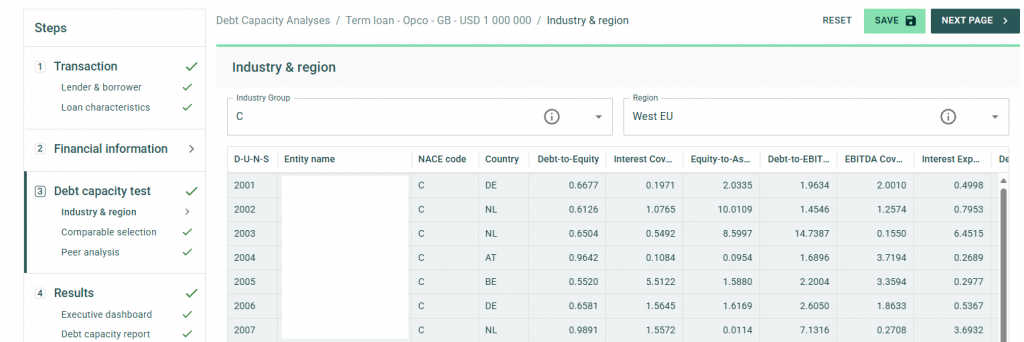
To streamline your in-house workflow, the standard package includes access to comparable data for a wide variety of borrowers. Within seconds, the application can automatically generate 40 comparable peers based on the borrower’s size, country, and industry through our connection with Dun & Bradstreet. Additionally, users can adjust and amend the list of comparable peers to ensure robust and tailored debt capacity tests for any scenario.
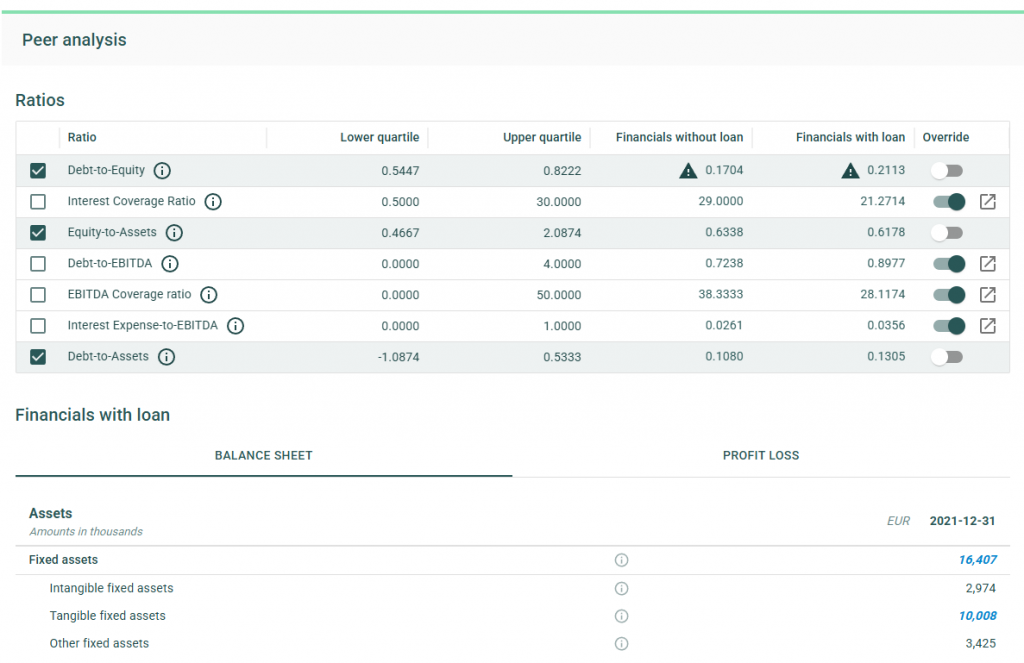
The debt capacity test leverages a flexible framework of financial ratios, which can be customized on a case-by-case basis. Our financial models dynamically adjust a borrower’s ratios to account for the impact of new loans on the balance sheet. With financial data for comparable entities readily available in the application, users receive feedback on debt capacity tests in under a minute.
Upon completing the analysis, the application offers the option to generate a comprehensive report, available in Word or PDF formats. This detailed report outlines the methodology and underlying data used in the analysis, serving as an excellent complement to existing pricing reports and providing critical compliance support when it matters most.
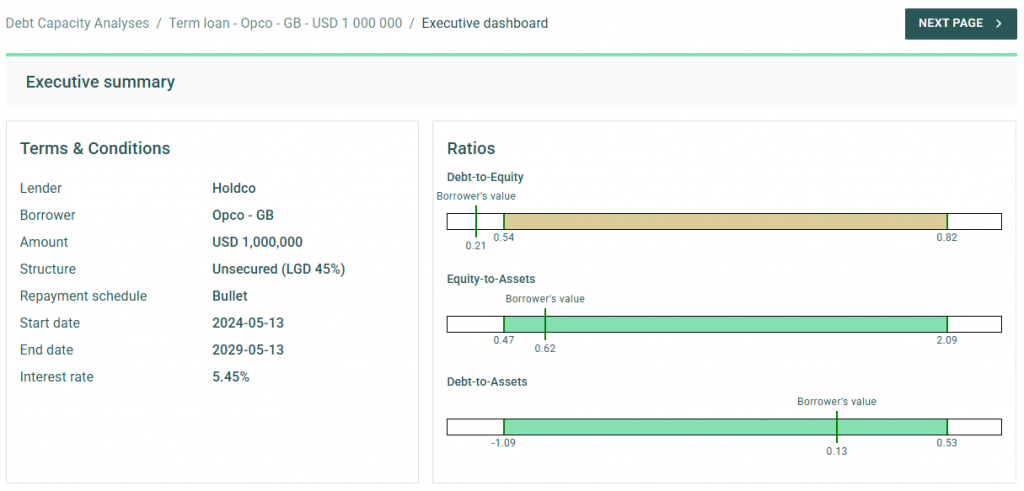
After releasing the initial version of the Debt Capacity module to clients, we will work on continuing to improve our applications. For example, by further supporting the debt capacity test through the inclusion of a dedicated cash flow forecast and an increase in comparable companies. If you’re interested in learning more, we invite you to contact our Transfer Pricing team to schedule a demo or trial the new module within your Zanders Inside environment.
Zanders Transfer Pricing Solution
As tax authorities intensify their scrutiny, it is essential for companies to carefully adhere to the recommendations outlined above. Does this mean additional time and resources are required? Not necessarily.
Technology provides an opportunity to minimize compliance risks while freeing up valuable time and resources. The Zanders Transfer Pricing Suite is an innovative, cloud-based solution designed to automate the transfer pricing compliance of financial transactions.
With over seven years of experience and trusted by more than 80 multinational corporations, our platform is the market-leading solution for intra-group loans, guarantees, and cash pool transactions.
Our clients trust us because we provide:
- Transparent and high-quality embedded intercompany rating models.
- A pricing model based on an automated search for comparable transactions.
- Automatically generated, 40-page OECD-compliant Transfer Pricing reports.
- Debt capacity analyses to support the quantum of debt.
- Legal documentation aligned with the Transfer Pricing analysis.
- Benchmark rates, sovereign spreads, and bond data included in the subscription.
- Expert support from our Transfer Pricing specialists.
- Quick and easy onboarding—completed within a day!
Learn more, and discover the key compliance challenges for intra-group loan transfer pricing in 2025.
- See our blog on Transfer Pricing best practices 2025 for more information. ↩︎
Boosting MVA Calculation efficiency: the power of GPU computing

We explore the main challenges of computing Margin Value Adjustment (MVA) and share our insights on how GPU computing can be harnessed to provide solutions to these challenges.
With recent volatility in financial markets, firms need increasingly faster pre-trade and risk calculations to react swiftly to changing markets. Traditional computing methods for these calculations, however, are becoming prohibitively expensive and slow to meet the growing demand. GPU computing has recently garnered significant interest, with advances in the fields of advanced machine learning techniques and generative AI technologies, such as ChatGPT. Financial institutions are now looking at gaining an edge by using GPU computing to accelerate their high-dimensional and time-critical computing challenges.
The MVA Computing Challenge
The timely computation of MVA is essential for pre-trade and post-trade modelling of bilateral and cleared trading. Providing an accurate measure of future margin requirements over the lifetime of a trade requires the frequent revaluation of derivatives with a large volume of intensive nested Monte Carlo simulations. These simulations need to span a high-dimensional space of trades, time steps, risk factors and nested scenarios, making the calculation of MVA complex and computationally demanding. This is further complicated by the need for an increasing frequency of intra-day risk calculations, due to recent market volatility, which is pushing the limits of what can be achieved with CPU-based computing.
An Introduction to GPU Computing
GPU computing utilizes graphics processing units, which are specifically designed to handle large volumes of parallel calculations. This capability makes them ideal for solving programming challenges that benefit from high levels of parallelization and data throughput. Consequently, GPUs can offer substantial benefits over traditional CPU-based computing, thanks to their architectural differences, as outlined in the table below.

A comparison of the typical capabilities of enterprise-level hardware for CPUs and GPUs.
It is because of these architectural differences that CPUs and GPUs excel in different areas:
- CPUs feature fewer but more powerful cores, optimized for general-purpose computing with complex, branching instructions. They excel in performing serial calculations with high single-core performance.
- GPUs consist of a large number of less powerful cores and with higher memory bandwidth. This makes them ideal for handling large volumes of parallel calculations with high throughput.
Solving the MVA Computational Challenge with GPU Computing
The requirement to calculate large volumes of granular simulations makes GPU computing especially well-suited to solving the MVA computational challenge. The use of GPU computing can lead to significant improvements in performance for not only MVA but a range of problems in finance, where it is not uncommon to see improvements in calculation speed of 10 – 100x. This performance increase can be harnessed in several ways:
- Speed: The high throughput of GPUs provides results more quickly, providing faster risk calculations and insights for decision-making, which is particularly important for pre-trade calculations.
- Throughput: GPUs can more quickly and efficiently process large calculation volumes, providing institutions with more peak computing bandwidth, reducing workloads on CPU-grids that can be used for other tasks.
- Accuracy: With greater parallel processing capabilities, the accuracy of models can be improved by using more sophisticated algorithms, greater granularity and a larger number of simulations. As illustrated below, the difference in the number of Monte Carlo simulations that can be achieved by GPUs in the same time as CPUs can be significant.

The difference in the number of Monte Carlo paths than can be simulated in the same time between an equivalent enterprise-level CPU and GPU.
Case Study: Our approach to accelerating MVA with GPUs
To illustrate the impact of GPU computing in a real situation, we present a case study of our work accelerating MVA calculations for a major bank.
Challenge: A large investment bank was seeking to improve the performance of their pre-trade MVA for more timely calculations. This was challenging as they needed to compute their MVA exposures over long time horizons, with a large number of paths. Even with a sensitivity-based approach, this process took close to 10 minutes using a single-threaded CPU calculation.
Solution: Zanders analyzed the solution and identified several bottlenecks. We developed and optimized a GPU-accelerated solution to ensure efficient GPU utilization, parallelizing the calculations across scenarios and risk factors.
Performance: Our GPU implementation improved MVA calculation speed by 51x. Improving calculation time from just under 10 minutes to 10 seconds. This significant increase in speed enabled more timely and frequent assessments and decisions on MVA.
Our Recommendation: A strategic approach to GPU computing implementations
There are significant benefits to be achieved with the use GPU computing. However, there are some considerations to ensure an effective use of resources:
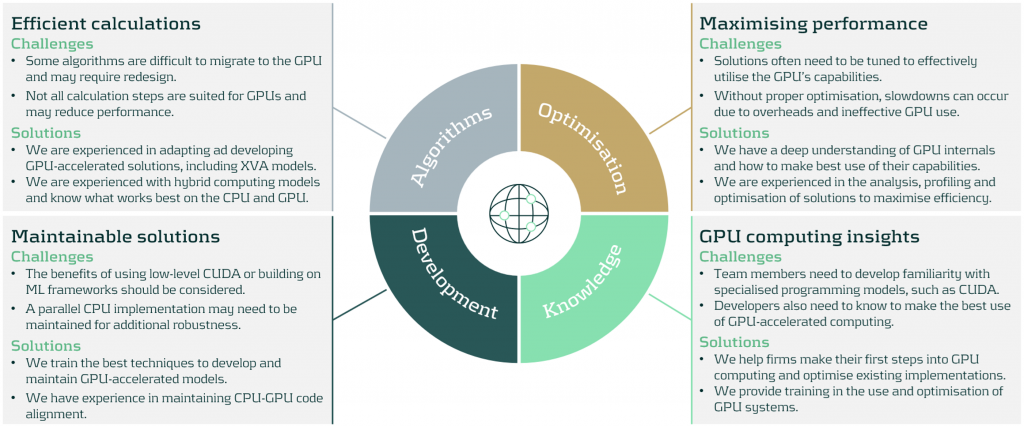
We work with firms to develop bespoke solutions to meet their high-performance computing needs. Zanders can help in all aspects of GPU computing implementation, from initial design to the analysis, development and optimization of your GPU computing implementation.
Conclusion
GPU computing offers significant improvements in the speed and efficiency of financial calculations, typically boosting calculation speeds by factors of 10-100x. This enables financial institutions to manage their risk more effectively, including the computationally demanding calculations of MVA. By replacing CPU-based calculations with GPU computing, banks can dramatically improve their capacity to process greater volumes of calculations with higher frequency. As financial markets continue to evolve, GPU computing will play an increasingly vital role in their calculation infrastructure.
To find out more on how GPU computing can enhance your institution's risk management processes, please contact Steven van Haren (Director) or Mark Baber (Senior Manager).
The EBA’s new IRRBB heatmap implementation: reporting on key objectives

Following the publication of its focus areas for IRRBB in 2024 and 2025, the European Banking Association (EBA) has now published an update regarding the implementation and explains the next steps.
The implementation update covers observations, recommendations and supervisory tools to enhance the assessment of IRRBB risks for institutions and supervisors.1 Main topics include non-maturing deposit (NMD) behavioral assumptions, complementary dimensions to the SOT NII, the modeling of commercial margins for NMDs in the SOT NII, as well as hedging strategies.
Some key highlights and takeaways from the results of sample institutions as per Q4 2023:
- Large dispersion across behavioral assumptions on NMDs is observed. The significant volume of NMDs as part of EU banks’ balance sheets, differences in behavior between customer / product groups and developments in deposit volume distributions, however, underline the need for more solid and aligned modeling. The EBA hence suggests NMD modeling enhancements and recommends (1) banks to consider various risk factors related to the customer, institution and market profile, as well as (2) a supervisory toolkit to monitor parameters / risk factors. Segmentation and peer benchmarking, (reverse) stress testing as well as (combining) expert judgment and historical data are paramount in this regard. The recommendations spark banks to reevaluate forward looking approaches, as shifting deposit dynamics render calibration solely based on historical data insufficient. Establishing a thorough expert judgment governance including backtesting is vital in this respect. Moreover, assessing and substantiating how a bank’s modeling relates to the market is more important than ever.
- Next to the NII SOT that serves as a metric to flag outlier institutions from an NII perspective, the EBA proposes additional dimensions to be considered by supervisors. These dimensions, which aim to reflect internal NII metrics, must complement the assessment and enhance the understanding of IRRBB exposures and management. The proposed dimensions include (1) market value changes of fair value instruments, (2) interest rate sensitive fees/commissions & overhead costs, and (3) interest rate related embedded losses and gains. It is important to note that it is not intended to introduce new limits or thresholds associated with these dimensions.
- Given concerns and dispersion regarding the modeling of commercial margins for NMDs in the NII SOT (38% of sample institutions assumed constant commercial margins versus the remainder not applying constant margins), the EBA now provided additional guidance on the expected approach. They recommend institutions to align the assumptions with those in their internal systems, or apply a constant spread over the risk-free rate when not available. Key considerations include the current spread environment, the context of zero or negative interest rates and lags in pass-through. The EBA’s clarification indicates that banks are allowed to apply a non-constant spread. This serves as an opportunity for banks still applying constant ones, as using non-constant spreads enhances the ability to quantify NII risk under an altering interest rate environment.
- Hedging practices vary significantly across institutions, although hedging instruments (i.e. interest rate swaps) to manage open IRRBB positions are aligned. Hedging strategies have significantly contributed to meeting regulatory requirements, with all institutions meeting the SOT EVE as per Q4 2023, compared to 42% that would not have complied if hedges were disregarded. For the SOT NII, however, 13% of the sample institutions would have been considered outliers if this regulatory measure had been applied in Q4 2023 (versus 21% when disregarding hedges). This result shows that it is key for banks to find a balance between value and earnings stability, and apply hedging strategies accordingly. As compliance with SOTs must be ensured under all circumstances, stressed client behavior and market dynamics must be accounted for.
In the upcoming years, the EBA will continue monitoring the impact of the IRRBB regulatory package, focusing on NMD modeling, hedging strategies, and potential scope extensions to commercial margin modeling. It will also assess Pillar 3 disclosure practices and track key regulatory elements such as the 5-year cap on NMD repricing maturity and Credit Spread Risk in the Banking Book (CSRBB)-related aspects. Additionally, the EBA will contribute to the International Accounting Standards Board’s (IASB's) Dynamic Risk Management (DRM) project and evaluate the impact of recalibrated shock scenarios from the Basel Committee.
The EBA publication triggers banks to take action on the four topics outlined above, as well as on hedge accounting (DRM) in the near future. Zanders has extensive relevant experience, and supported on:
- Numerous NMD topics, including modeling, validation and benchmarking. Furthermore, we published a series of whitepapers regarding NMD modeling concepts and approaches, deposit rate dynamics, forward looking perspectives and migration dynamics in deposits that is particularly relevant following this EBA publication.
- Drafting an IRRBB strategy, advising on coupon stripping and developing a hedging strategy, thereby carefully balancing value and NII risks (SOT EVE / NII).
- Validating a hedge accounting framework, developing a hedge account model and hedge accounting outsourcing. Zanders moreover held a survey on DRM as well as published an extensive series of articles on the DRM project of the IASB and its implications for banks.
Contact Jaap Karelse, Erik Vijlbrief (Netherlands, Belgium and Nordic countries) or Martijn Wycisk (DACH region) for more information.
Intra-group Loan Transfer Pricing: What’s new in 2025?

Discover the key compliance challenges for intra-group loan transfer pricing in 2025.
Over the past year, the interest rates on intercompany financial transactions have come under closer examination by tax authorities. This intensified scrutiny stems from a mix of factors, including evolving regulations, more sophisticated audit procedures, the need from governments to boost revenue, and of course, high-interest-rate environment.
As a result, these transactions are now being assessed with greater depth and rigor than ever before. Historically, tax authorities focused on interest rate benchmarks as the primary point of analysis. However, their attention has now widened significantly to cover a range of interrelated considerations.
Below is a brief overview of the key trends and areas attracting the most scrutiny in today’s landscape, highlighting what multinationals should pay attention to in 2025:
Arm’s length T&Cs
In the past years, tax authorities are closely examining the terms and conditions of intra-group debt, scrutinizing the pricing of loans and the effects of increased leverage.
Accordingly, it is critical to ensure that the loan’s terms and conditions reflect the arm’s length standards and align with the actual economic substance of the transaction. This includes evaluating whether a hypothetical independent borrower, under similar conditions, could and would obtain a comparable loan.
In addition to establishing an arm’s length interest rate and the appropriate amount of debt (further explained below), it is also necessary to assess whether the other terms and conditions are at arm’s length. This involves considering the main features of the loan—such as currency, maturity, repayment schedule, and callability—and evaluating their impact on the risk profile of both the borrower and the lender, as well as on the arm’s length interest rate.
In this regard, tax authorities may challenge intra-group loans that do not include a maturity date, have an excessively long maturity (e.g., over 25 years), or lack a repayment schedule, since third-party loans would generally include these provisions.. They might also challenge situations where the actual conduct of the parties does not reflect the terms and conditions outlined in the loan agreement. For example, if the parties apply a different maturity or repayment schedule than the one initially agreed upon—without amending the legal documentation, which often happens in a dynamic intra-group financing environment—this could prompt further scrutiny from tax authorities.
As a result, it is important for multinational enterprises to carefully consider these terms and conditions before issuing a loan, as they will have a direct impact on the interest rate applied in the transaction. Drafting a comprehensive loan agreement that clearly outlines these terms, aligns with the conditions applied in practice, and is supported by a robust Transfer Pricing analysis is recommended to mitigate the risk of challenges by tax authorities.
Debt Capacity Analysis
One of the most important terms and conditions that must meet arm’s length standards is the so-called quantum of debt (i.e. nominal amount of the loan extended). Tax authorities are increasingly scrutinizing whether the amount of intra-group debt is economically justified and supported by a clear business purpose. They also evaluate whether the debt aligns with arm’s length principles and serves a legitimate economic function consistent with the borrower’s overall business strategy.
A debt capacity analysis is often conducted to determine whether the borrower has the financial capacity to repay the loan and whether an unrelated party would provide a similar amount of financing under comparable conditions.
While many jurisdictions have long required this type of analysis in practice, Germany has taken a step further by formalizing this requirement under its 2024 Growth Opportunities Act. This was further clarified on December 12, 2024, when the German Federal Ministry of Finance issued administrative principles providing specific guidance on financing relationships under the new Transfer Pricing provisions. According to these principles, the debt capacity test hinges on two key criteria:
(i) a credible expectation that the debtor can meet its obligations (e.g., interest payments and principal repayments),
and (ii) a commitment to provide financing for a defined period.
As a result, multinational enterprises are expected to robustly justify the level of debt assumed by their subsidiaries, particularly for entities operating in Germany.
Credit Rating Analyses
Tax authorities are increasing their focus on credit rating analyses. While simplified approaches, such as applying a uniform credit rating across all subsidiaries, were once more widely accepted, current practices favour a more detailed entity by entity evaluation. This involves first assigning a stand-alone credit rating to the individual borrower and then adjusting it to account for any implicit or explicit group support.
In this context, Swiss tax authorities published last year a Q&A addressing various Transfer Pricing topics. In the section on financial transactions, they emphasized a clear preference for the bottom-up approach described above. This aligns closely with the OECD Transfer Pricing Guidelines and is consistent with the prevailing practices in most jurisdictions.
In contrast, the administrative principles issued in Germany appear to take a different direction. According to the new rules, the arm’s-length nature of the interest rate for cross-border intercompany financing arrangements must generally be determined based on the group’s credit rating and external financing conditions. However, taxpayers are allowed to demonstrate that an alternative rating better aligns with the arm’s-length principle.
This new approach diverges not only from the OECD guidelines but also from previous case law established by the German Federal Tax Court. As a result, several questions arise regarding how these rules will be applied in practice by German tax authorities. For instance, it remains unclear whether this approach will constitute a strict obligation or whether flexibility will be granted. Additionally, concerns exist about the burden of proof placed on taxpayers when opting for the bottom-up approach recommended by the OECD Transfer Pricing Guidelines.
Cash Pool Synergy Distribution
Tax authorities are increasingly aligning with Chapter X of the OECD Guidelines when evaluating cash pooling arrangements, with particular attention to the distribution of synergies among pool participants.
According to the OECD Transfer Pricing Guidelines (Section C.2.3.2, paragraph 10.143), synergy benefits should generally be allocated to pool members by determining arm’s length interest rates that reflect each participant’s contributions and positions within the pool (e.g., debit or credit).
Historically, the focus of tax authorities was primarily on the pricing methodologies— ensuring that both deposit and withdrawal margins were set at arm’s length. However, there is now a growing emphasis on how synergy benefits are distributed among participants. This is especially significant in jurisdictions where participants make substantial contributions to the pool balance. According to the OECD guidelines, these participants should benefit from the synergies generated by the pool through more favourable financing terms.
To address these requirements and reduce the risk of disputes over cash pool structures, a three-step approach is recommended:
1- Price the credit and debit positions of the participants.
2- Calculate the synergy benefits generated within the structure.
3- Allocate these benefits between the Cash Pool Leader and participants by adjusting the price applied to the participants.
By following this approach, multinationals can ensure compliance with OECD guidelines and mitigate the likelihood of challenges from tax authorities.
Zanders Transfer Pricing Solution
As tax authorities intensify their scrutiny, it is essential for companies to carefully adhere to the recommendations outlined above.
Does this mean additional time and resources are required? Not necessarily.
Technology provides an opportunity to minimize compliance risks while freeing up valuable time and resources. The Zanders Transfer Pricing Suite is an innovative, cloud-based solution designed to automate the transfer pricing compliance of financial transactions.
With over seven years of experience and trusted by more than 80 multinational corporations, our platform is the market-leading solution for intra-group loans, guarantees, and cash pool transactions.
Our clients trust us because we provide:
- Transparent and high-quality embedded intercompany rating models.
- A pricing model based on an automated search for comparable transactions.
- Automatically generated, 40-page OECD-compliant Transfer Pricing reports.
- Debt capacity analyses to support the quantum of debt.
- Legal documentation aligned with the Transfer Pricing analysis.
- Benchmark rates, sovereign spreads, and bond data included in the subscription.
- Expert support from our Transfer Pricing specialists.
- Quick and easy onboarding—completed within a day!
Introducing Our New Partner: Driving Growth and Innovation in the DACH Region

At Zanders, we are proud to announce the promotion of Tobias Westermaier as our newest partner.
At Zanders, we are proud to announce the promotion of Tobias Westermaier as our newest partner. With a rich background in Corporate Finance and Treasury, he brings a wealth of experience and a clear vision to support the growth of our Treasury Advisory Group in the DACH region. We caught up with him to learn more about his career journey, aspirations, and insights into the future of our industry.
A Career Built on Global Expertise
“I’ve spent my whole career in Corporate Finance and Treasury roles, working within corporates, banks, and consulting,” Tobias shares. “I joined Zanders Switzerland in 2014 after returning from Asia and was fortunate to work on a variety of projects both in Switzerland and internationally. In 2021, I rejoined Zanders, after gaining further experience in Corporates and Investment Banking in Zurich, to lead the Swiss Treasury Advisory team and help expand Zanders’ footprint in Switzerland and the broader DACH region.”
This journey, marked by diverse experiences and consistent growth, has prepared Tobias for his new role as a partner at Zanders.
Excitement for the New Role
When asked about what excites him most about becoming a partner, Tobias highlights two key areas: growth and collaboration. “I am very much looking forward to actively shaping the Zanders growth story. In particular, I am excited to build and lead our Treasury Advisory Group in the DACH region. Working towards ambitious goals with my outstanding colleagues gives me the most energy. Empowering the team to unlock their full potential will be key to delivering great results for our clients.”
What Makes Zanders Unique
For Tobias, Zanders stands out as a company that truly lives its values of Freedom, Fun, and Collaboration. “The entrepreneurial spirit at Zanders allows everyone to contribute, evolve, and implement ideas. We see opportunities, not obstacles. Cross-departmental and regional collaboration is part of our DNA - we operate as One Zanders. And while we’re passionate about delivering high-quality results for our clients, we never forget to have fun as a group!”
Mentors and Influences
Reflecting on his career, Tobias emphasizes the importance of having trusted mentors and colleagues. “Fortunately, from most of my career steps, colleagues or mentors have remained part of my journey. Having trustful relationships with people who can provide unbiased opinions, new perspectives, or hold up a mirror is invaluable. I encourage everyone to seek such external reflections.”
Industry Trends and Developments
Looking ahead, Tobias is particularly excited about the transformative potential of Artificial Intelligence (AI). “AI is on top of my mind. It will fundamentally change how we work, especially in the consulting industry, and open new opportunities for us and our clients’ business cases.”
Vision for Zanders’ Future
With a steep growth trajectory, Zanders is poised to become the financial performance partner of choice globally. Tobias sees his role as instrumental in achieving this vision. “My contribution focuses on two key areas: (i) growing our presence in the DACH region, and (ii) expanding our service offering for the Office of the CFO. With our expertise, project track record, and global presence, Zanders is well-positioned to achieve its ambitious goals.”
Celebrating the Future
We are very excited to have Tobias join the partner team and contribute to Zanders’ mission of delivering exceptional value to our clients. His leadership, vision, and expertise will undoubtedly propel us forward as we continue to grow and innovate. Congratulations, on this well-deserved promotion!
Insights into XVA Calculations: how to harness the power of neural networks

Discover how neural networks are revolutionizing XVA calculations, delivering unprecedented speed, efficiency, and agility for the banking industry.
Introduction: Faster, smarter, and future-proof
In the fast-paced financial industry , speed and accuracy are paramount. Banks are tasked with the complex calculation of XVAs (‘X-Value Adjustments’) on a daily basis, which often involve computationally expensive Monte Carlo simulations. These calculations, while crucial, can become a bottleneck, slowing down decision-making processes and affecting efficiency. What if there is a faster and smarter way to handle these calculations? In this article, we explore a revolutionary approach that uses neural networks to drastically accelerate XVA calculations, promising significant speed-ups without sacrificing accuracy.
The traditional approach: Monte Carlo simulations and their limitations
Traditionally, banks have relied on Monte Carlo simulations to calculate XVAs. These simulations involve numerous complex scenarios, requiring substantial computational power and time. Imagine running simulations endlessly, with every tick of the clock translating to computing expenses. The problem? Time and resources. These calculations must be repeated daily, leading to significant delays and costs, potentially hindering your bank's responsiveness and decision-making agility.
Despite bringing precision, this traditional method poses challenges. Given that the rates offered by banks do not fluctuate dramatically within days, repeating these extensive simulations seems redundant. This redundancy leads us to seek a solution that can deliver both speed and efficiency, paving the way for innovation.
A new era: Leveraging Neural Networks for speed and efficiency
Enter neural networks—an innovative technology that promises a solution to the Monte Carlo conundrum. By training these networks on Monte Carlo simulations conducted early in the week, such as on a Monday, the model can predict outcomes for the rest of the days. This approach sidesteps the need to perform cumbersome computations daily.
Here’s how it works: The neural network learns from initial data, absorbing patterns and information that remain relatively constant through the week. This enables it to approximate net present value calculations with astonishing speed and accuracy. A practical example? Our integration of this technique into the Open-source Risk Engine resulted in a remarkable 600% increase in speed when assessing interest rate swap exposure in a stable market.
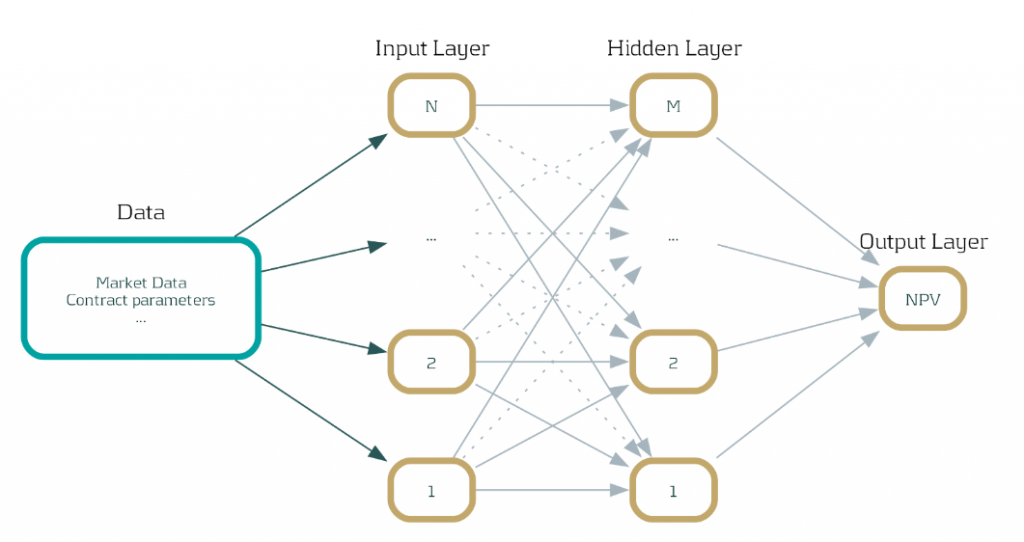
Benefits of our solution: Integration and acceleration
- Seamless Integration: Our solution can be seamlessly integrated with any existing systems, as long as they provide net present value outputs for some simulations.
- Scalability with GPUs: Neural network calculations can harness the parallel processing power of GPUs, exponentially increasing inference speed. Imagine every inference equating to calculations for numerous trades simultaneously.
- Feasibility and Reliability: With approximation of net present values being a commonly accepted practice in finance, this approach is both feasible and reliable for banks striving for rapid insights.
Zanders Recommends: A strategic approach to implementation
At Zanders, we believe in empowering banks with cutting-edge technology that aligns with their growth ambitions. Here is what we recommend:
1- Assessment Phase: Evaluate the current computational model and identify areas that can benefit from the implementation of neural networks.
2- Pilot Programs: Start with small-scale implementations to address specific bottlenecks and measure impact.
3- Utilize GPUs: Leverage the parallelization capabilities of GPUs not just for neural networks but also for Monte Carlo simulations themselves, if needed.
4- Continuous Improvement: Regularly update neural network models to ensure accuracy as market conditions evolve.
Our extensive experience with high-performance computing, particularly the use of GPUs for parallelization, positions us as a trusted partner for banks navigating this transformation journey.
Expertise spotlight: High-Performance Computing and AI solutions
In addition to revolutionizing XVA calculations, Zanders offers robust high-performance computing solutions that maximize the capabilities of GPUs across various applications, including Monte Carlo simulations. Our expertise also extends into AI technologies such as chatbots, where we implement and validate models, ensuring banks remain at the forefront of innovation.
Conclusion: Embrace the future of banking technology
As the financial world evolves, so must the technologies that drive it. By leveraging neural networks, banks can achieve unprecedented speed and efficiency in XVA calculations, providing them with the agility needed to navigate today's dynamic markets. Now is the time to embrace a solution that is not only faster but smarter. At Zanders, we're ready to guide you through this transformation. Get in touch with Steven van Haren to learn how we can elevate your XVA calculations and ensure your bank stays competitive in an ever-changing financial landscape.
Unlocking Value Through Foreign Exchange (FX) Risk Management: A Blueprint for Private Equity

Explore the overlooked role of FX risk management in enhancing portfolio company value.
In the high-stakes world of Private Equity (PE), where exceptional returns are non-negotiable, value creation strategies have evolved far beyond financial engineering. Today, operational improvements, including in treasury and financial risk management, are required to yield high-quality returns. Among these, FX risk management often flies under the radar but holds significant untapped potential to protect and drive value for portfolio companies (PCs). In this article, we explore the importance of identifying and managing FX risks and suggest various quick wins to unlock value for portfolio companies.
The Untapped Potential of FX Risk Management in Value Creation
PCs operating across multiple countries frequently lack a cohesive treasury and financial risk management approach. For example, bolt-on acquisitions often lead to fragmented teams, processes, systems and banking structures, while exposure to an increasing number of currencies creates financial risk that often remains invisible to central teams. This complexity is exacerbated by ad hoc and localized FX hedging practices, where PCs may not have access to competitive FX rates from their banking partners or access to a multi-bank FX dealing platform.
For PE firms, FX risk often represents a hidden drain on EBITDA and cash flow. FX mismanagement can erode margins and impact portfolio company value. Hence the importance of uncovering financial and operational inefficiencies and building streamlined processes to manage FX exposures effectively. Proper FX risk management, which goes beyond hedging by means of financial instruments, not only mitigates financial risk but directly contributes to value creation by reducing cash flow volatility, reducing costs, increasing control, and increasing transparency.
In this simplified example, a private equity-owned manufacturing firm, focused on expansion into emerging markets, was losing millions annually due to unmanaged foreign exchange (FX) exposures. The culprit? Decentralized treasury processes, idle bank balances in multiple currencies, and hidden FX risks within operational flows. The firm can address and manage these inefficiencies by using FX forward contracts to lock in exchange rates for future transactions and employing centralized treasury technology to monitor and control FX exposures across all operations. By addressing the inefficiencies, the firm reduced financial losses, stabilized its margins, and reinvested savings from FX gains into growth initiatives.
Quick Wins in FX Risk Management
In your search of value creation, we suggest two potential quick wins to unlock PC value.
Enhance Exposure Visibility
Check whether your PCs operate with a clear understanding of their FX exposure landscape. Conducting a quick scan early in the investment lifecycle should identify, amongst others:
- Where exposures are originated (e.g., revenues, costs, intercompany transactions) and if there are natural hedging possibilities.
- Idle cash balances or loans in nonfunctional currencies, which create FX volatility.
- The potential impact of these exposures on financial results through FX risk quantification.
Private equity sponsors can facilitate the creation of a centralized treasury function that i) establishes a policy and process for FX risk management, ii) implements an FX dealing platform for efficient and competitive FX trading with banks, iii) monitors balances to reduce cash balances in non-functional currencies, and iv) implements netting arrangements to streamline intercompany payments and minimize cross-border transactions.
Hidden FX Risk Discovery
Business practices, such as allowing customers to pay in multiple currencies or a pricing agreement based on currency conversions, often lead to hidden FX risks and are a common pain point which is overlooked. For instance, a PC may receive customer payments in USD but agree to link the actual payable amount to the EUR/USD exchange rate, creating an implicit EUR exposure that impacts margins and cash flow.
To address hidden FX risks, a private equity sponsor can help portfolio companies achieve a quick win by conducting a thorough analysis of their pricing models and operational agreements to identify implicit currency exposures, then implementing (soft) hedging techniques, such as adjusting pricing strategies to match revenue and cost currencies, renegotiating contracts with suppliers and customers to align payment terms, and utilizing natural hedging opportunities like balancing currency inflows and outflows, thereby minimizing net exposure before deciding to resort to financial instruments.
In summary, as illustrated by the above quick wins, streamlining treasury processes can yield:
- Hard dollar savings: Reduced FX costs by accessing competitive spreads.
- Soft dollar savings: Enhanced decision-making through better visibility on exposures and reduced operational complexity.
Consider this: A PE-owned retail chain expanded into international markets and faced profit erosion due to unmanaged FX risks and fragmented treasury processes. The sponsor conducted a quick scan to map exposures, uncovering mismatched revenue and expense currencies, a scattered landscape of bank accounts with idle balances, and operational inefficiencies. Hidden FX risks, such as supplier pricing tied to EUR/USD rates and uncoordinated customer payment options in multiple currencies, were also identified. Leveraging these insights, the sponsor centralized FX management by consolidating bank accounts, aligning supplier contracts with revenue streams to create natural hedges, and introducing competitive trading for FX transactions. They also established internal multilateral netting to streamline intercompany settlements, reducing FX costs by 20%.
Measurable Results
Integrating exposure identification and quantification, hidden risk discovery, and treasury process optimization into a single strategy enables PE firms to achieve more stable margins, cost savings, improved cash flow predictability and liberates capital for reinvestment. Furthermore, a proactive approach to FX risk management provides improved transparency for decision-making and LP reporting and strengthens financial resilience against market volatility. By embedding these robust treasury and financial risk management practices, PE sponsors can unlock hidden potential, ensuring their portfolio companies are not only protected but also positioned for sustainable growth and profitable exits.
Conclusion
In the dynamic world of private equity, optimizing FX risk management for internationally operating PCs is a crucial strategy for safeguarding and enhancing portfolio value. Reflect on your current FX risk strategies and identify potential areas for improvement. Are there invisible exposures or inefficiencies limiting your portfolio’s growth? Take the initiative today - evaluate your FX risk management practices and make the necessary refinements to unlock substantial value for your portfolio companies. Embrace the opportunity to drive significant improvements in their financial resilience and overall performance.
If you're interested in delving deeper into the benefits of strategic treasury management for private equity firms, please contact Job Wolters.
Zanders Gives Back: Making December a month of Giving

Spreading festive cheer and fostering community connections through a heartfelt Christmas high tea for local residents in Amsterdam.
For many, December is the most magical time of the year. It is a season filled with the warmth of family members, the joy of hanging out with friends, and the coziness of gathering around the Christmas tree with Christmas music in the background. It can be said that December is a month of celebration, reflection and gratitude. Yet, amidst the laughter and the shared moments, it's important to remember that for some, this season can also spark feelings of loneliness and hardship.
The true beauty of the holiday season is the part where we give back. We take a moment to extend our kindness and take the opportunity to give back to our communities, to reach out to those who may be struggling, and to make the season a little brighter for everyone. With this in mind, we at Zanders, organized a great initiative called “Zanders Gives Back” that is in line with the spirit of December: a period of solidarity, giving and time together.

With 19 enthusiastic volunteers, we brought festive cheer to a local community house in Amsterdam Oost, a safe neighborhood meeting space where young and old gather to connect with fellow residents, enjoy a nice cup of coffee, receive support, and stay active. Our team organized a Christmas high tea lunch for 50 local residents, who are all part of the wider community. Divided into groups, each with a specific task and clear instructions to ensure that the food was ready on time. We worked together to prepare a nice high tea including delicate sandwiches, colorful fruit sticks, devilled eggs and mozzarella sticks. Meanwhile, others folded napkins and created thoughtful place cards with a nice holiday message to the tables.
After finishing the food preparations, we started decorating the room, stringing garlands along the walls to create a festive atmosphere, and we made sure to have plenty of tea and coffee ready to serve. Just before the guests arrived, we prepared the freshly baked croissants and bagels on the tables, all ready to go for a nice Christmas high tea.

Serving coffee and tea became an opportunity to connect further, listening to local residents, each with their own personal story. It wasn’t just about the food or the decorations. It was about celebrating Christmas together, bridging gaps, and making everyone feel part of something special. Throughout the lunch, laughter was shared, kind words were said, and joy was simply present.
As the afternoon came to an end, we reflected on the impact of this simple yet meaningful gesture. The high tea lunch reminded us of the importance of kindness, the value of community, and the power of working together toward a shared goal. Not only did this experience allow us to give back, but it also strengthened our bond as colleagues, making it a truly memorable day.
At Zanders, we believe that giving back to the community is not just a responsibility but it’s an integral part of who we are. Initiatives like "Zanders Gives Back" allow us to live out our values, making a meaningful impact on the community while fostering a sense of purpose and connection among our team.
Such initiatives are important because they provide us with the opportunity to step outside of our daily work, come together as a team, and contribute to something bigger than ourselves. By engaging with the community, we not only spread joy and support those who may feel lonely or in need, but we also strengthen the bond between our employees, creating shared memories and deepening relationships in a way that goes beyond the workplace. Volunteering activities like this remind us of the power of kindness and connection. They exemplify our commitment to being a company that cares, not only about what we do but about the world we’re helping to shape and make a positive difference.

PRA regulation changes in PS9/24

The PRA’s near-final Rulebook PS9/24 introduces critical updates to credit risk regulations, balancing Basel 3.1 alignment with industry competitiveness, and Zanders offers expert support to navigate these changes efficiently.
The near-final PRA Rulebook PS9/24 published on 12 September 2024 includes substantial changes in credit risk regulation compared to the Consultation Paper CP16/22. While these amendments enhance clarity of Basel 3.1 implementation, institutions should conduct in-depth impact analysis to efficiently manage capital requirement.
PRA has published draft proposal CP16/22 aligning closely with Basel 3.1 reforms. In response to industry feedback, the PRA has made material adjustments in PS9/24, which are aimed at better balancing alignment with international standards and maintaining the competitiveness of UK regulated institutions.
Key takeaways
1- Scope for a ‘Backstop’ revaluation every 5-years for valuation of real estate exposures
2- SME and Infrastructure support factor is maintained, yet firm-specific adjustments will be introduced in pillar 2A.
3- Despite industry concern on international competitiveness, the risk-sensitive approach for unrated corporate exposure is maintained.
The implementation timeline is extended to 1 January 2026 with a 4-year transitional period, which is a one-year delay from the proposed implementation date of 1 January 2025 from CP16/22.
Real Estate Exposures
According to the final regulations, the risk weights associated with regulatory real estate exposure will be calculated based on the type of property, the loan-to-value (LTV) ratio, and whether the repayments rely significantly on the cash flows produced by the property. In place of the potentially complex analysis proposed in CP16/22, the rules for determining whether a real estate exposure is materially dependent on cash flows have been significantly simplified and there is now a straightforward requirement for the classification of real estate exposures.
One major change in the proposals relates to loans that are secured by commercial properties. The PRA has dropped the 100% risk weight floor for exposures backed by commercial real estate (CRE), provided that the repayment is not 'materially dependent on cash flows from the property' and that the exposure fits the 'regulatory real estate (RRE)' definition. Consequently, under the new rules, firms may, in some instances, benefit from low risk weights for commercial real estate, depending on the loan's loan-to-value (LTV) ratio and the type of counterparty involved.
Additionally, the final rules regarding the revaluation of real estate have become more risk-sensitive. Although firms are still required to use the original valuation to calculate LTV, there is now a provision allowing for a ‘Backstop’ revaluation after five years. Going forward, the PRA has eliminated the need for firms to adjust valuations to reflect the 'prudent value' sustainable throughout the loan's duration. The requirements for downward revaluation have been simplified, mandating firms to reevaluate properties when they estimate a market value decline of over 10%. Furthermore, the PRA has specified that valuations can be conducted using a robust statistical model, such as an automated valuation model (AVM).
SME support factor
The PRA has maintained the draft proposal to remove the SME support factor under SA and IRB (Pillar 1), but has applied a firm-specific structural adjustment to Pillar 2A (the ‘SME lending adjustment’). The ‘SME lending adjustment’ aims to absorb the impact of removing the SME support factor in overall capital requirement.
The PRA plans to communicate the adjusted Pillar 2 requirements to firms, ahead of the implementation date of the Basel 3.1 standards on 1 January 2026 (‘day 1’), so that firm-specific requirements will be updated at the same time as the Basel 3.1 standards are implemented.
Infrastructure support factor
The PRA has maintained the draft proposal to remove infrastructure support factor under SA and IRB approach, but has made two material changes which will diminish the impact on overall capital requirement.
i. apply a firm-specific structural adjustment to Pillar 2A (the ‘SME lending adjustment’), which will minimize disruption in overall capital requirement.
ii. introduce a new substantially stronger category in the slotting approach for IRB. PRA proposed lower risk-weight on the ‘substantially stronger’ IPRE exposures in CP16/22. The new definition of ‘substantially stronger’ is expected to include broader scope of IPRE exposures, thus lowering overall capital requirement.
Unrated corporate exposures
The PRA has maintained the draft proposal of introducing a two-way method on unrated corporate exposures: risk-sensitive and risk-neutral approach. Since the new approach does not apply in other jurisdictions, additional operational challenge is expected. Also, the 135% risk-weight on Non-IG(non-Investment Grade) unrated corporate exposure is higher than 100% in other jurisdictions, implying higher lending cost for UK regulated banks compared to its internationally regulated peers.
i. risk-sensitive approach : The PRA has proposed a risk-sensitive approach additional to the Basel III reforms. Exposures assessed by firms as IG would be risk-weighted at 65%, while exposures assessed by firms as Non-IG would be risk-weighted at 135%. This is a more risk-sensitive approach which aims to maintain an aggregate level of RWAs broadly consistent with the Basel III reforms.
ii. risk-neutral approach: 100% risk weight is applied where the risk-sensitive approach is too costly or complex.
In conclusion, the PRA's near-final Rulebook (PS9/24) reflects significant revisions to credit risk regulation that enhance clarity and alignment with Basel 3.1, while addressing industry feedback. The introduction of a five-year 'backstop' revaluation for real estate exposures, firm-specific adjustments for SMEs and infrastructure support factors, and the maintenance of a risk-sensitive approach for unrated corporate exposures underscore the PRA's commitment to balancing regulatory requirements with maintaining the competitiveness of UK institutions.
The extended implementation timeline to 1 January 2026, along with the transitional period, allows firms adequate time for adjustment. Overall, these changes aim to foster a more robust and competitive banking environment, while also navigating the complexities introduced by differing international standards.
How can Zanders help?
We have extensive experience of implementation and validation of Pillar 1 & 2 models which allows us to effectively support our Clients managing the change process to full compliance with the latest regulations.
From our experience, as the following are key areas on which our services can add most value:
1- Carry out thorough self-assessment against new requirements including an impact analyses of new regulations on their capital requirements.
2- Support model development activities to align models to new rules; we could be done either on an advisory basis or via direct supply of additional resources
3- Support amendments to Pillar 2 models (which will have to reflect changes to Pillar 1 models)
4- Support Internal Validation activities across Pillar 1 & 2
5- Carry out quality assurance on final models & documentation before final submission to the PRA
6- Support adoption of solutions for prudential valuation of (real estate) collateral while integrating climate risk information.
Please reach out to Paolo Vareschi or Suneet Dutta Roy to find out more about how we could support you on your journey to Basel 3.1 compliance.
References
[1] Bank of England (2024), PS9/24 – Implementation of the Basel 3.1 standards near-final part 2 URL PS9/24
[2] Bank of England (2022), CP16/22 – Implementation of the Basel 3.1 standards
URL CP16/22
How BCBS 239’s RDARR Principles Can Strengthen Risk Data Aggregation and Reporting in Financial Institutions

This blog explores how financial institutions can enhance their risk data aggregation and reporting by aligning with BCBS 239’s RDARR principles and the ECB’s supervisory expectations.
The ECB Banking Supervision has identified deficiencies in effective risk data aggregation and risk reporting (RDARR) as a key vulnerability in its planning of supervisory priorities for the 2023-25 cycle and has developed a comprehensive, targeted supervisory strategy for the upcoming years.
Banks are expected to step up their efforts and improve their capabilities in Risk Data Aggregation and Risk Reporting as Risk Data Architectures and supporting IT infrastructures are insufficient for most of the Financial Institutions. Hence, RDARR principles are expected to become more and more important during Internal Model Investigations and OnSite Inspections by the ECB.
In May 2024, the ECB published the Guide on effective risk data aggregation and risk reporting to ensure effective processes are in place to identify, manage, monitor and report the risks the institutions are or might be exposed to. With it, the ECB details its minimum supervisory expectations for a set of priority topics that have been identified as necessary preconditions for effective RDARR.
The ECB identifies seven priority areas, considered important prerequisites for robust governance arrangements and effective processes for identifying, monitoring and reporting tasks. The scope of application of these principles is reporting, Key Internal Models and other important models (e.g., IFRS9):

Relevance of BCBS 239
RDARR represents the implementation of the principles outlined in BCBS 239, which was published by the Basel Committee on Banking Supervision (BCBS) in 2013. BCBS 239 is essential to maintain regulatory compliance, mitigate risks, and drive data-driven decision-making. Non-compliance can result in significant financial penalties, reputational damage, and increased scrutiny from regulatory bodies. Therefore, BCBS 239 is a crucial framework that enhances financial stability by setting robust standards for risk data aggregation and reporting. Its principles encourage institutions to embrace data-driven practices, ensuring resilience, transparency, and efficiency. While challenges such as legacy infrastructure, data quality, and evolving risks persist, banks can overcome these hurdles through strategic investment in governance, technology, and data-driven culture to build end-to-end data transparency.
Zanders’ view on supervisory planning
We believe the following 5 topics of the RDARR principles are of major importance for financial institutions:

Establishing an effective program to review and address these topics, considering the nature, size, scale and complexity of each financial institution, will facilitate alignment with the ECB’s expectations.
Zanders experience on RDARR implementation
Data extends beyond being merely a technical database; it is a fundamental component of an organization’s strategic framework. Data-driven organizations are not defined solely by their technological solutions, but by the data culture across the entire organization. At Zanders, we have assisted clients in developing data strategies aligned with RDARR principles and supported the implementation of future-proof data utilization, including the integration of advanced tools such as AI.
One critical observation is that organizations must urgently address key questions regarding their data: What governance structures are currently in place? Are roles and responsibilities within this governance framework clearly defined? Is the governance being effectively implemented as planned? What training, guidance, and support do employees require? Are data definitions and requirements consistently aligned across all stakeholders? When undertaking such an extensive program, institutions must carefully consider whether a top-down or bottom-up approach will be most effective. In the case of RDARR, success necessitates a comprehensive, dual-directional approach that fosters change across all levels.
If you are unsure about your compliance with BCBS 239 and RDARR requirements, contact us today to ensure alignment with best practices.


